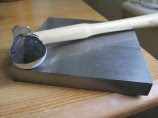This is the first in a series of handy info and tips for anyone interested in making Wirework jewellery.
First of all let me explain that I am by no means an expert in Wirework! I've been making Wirework jewellery for nearly three years and am self~taught: everything I have learnt has come from the internet, books and DVDs. But I have so much more to learn and so much more practising to do!
First things first ~
Tools
First of all let me explain that I am by no means an expert in Wirework! I've been making Wirework jewellery for nearly three years and am self~taught: everything I have learnt has come from the internet, books and DVDs. But I have so much more to learn and so much more practising to do!
First things first ~
Tools
There is a wide variety of jewellery making tools available for Wirework, some are absolutely necessary, some you can live without!
Pliers
You need several different types of pliers for Wirework ~ these are the pliers I use everytime I make a piece of Wirework jewellery ~
Roundnose Pliers ~ for creating loops and round bends
Chainnose Pliers ~ for creating bends, tucking in ends of wire and holding the wire
Flatnose pliers ~ for creating bends, holding the wire whilst making spirals, flattening wire
Wire cutters ~ Cutting wire (obviously!) Make sure you buy a pair that cut the wire flush (flat) at the end
Another pair of pliers that are very useful but not absolutely necessary when you start making Wirework jewellery are Nylon~Jawed pliers. The jaws are made of hard nylon which won't mark the wire and are used to straighten your wire before you start work. They also can be used to grip the wire as you work with it, although I find they don't grip very well but then mine are pretty mangled now!
Hammer And Bench Block
A bench block is a small piece of steel used with a Chasing or Ball Peen hammer to flatten wire, which in turn hardens it and adds interest to the design. The round end of a Ball Peen hammer can also be used to add texture to the wire. Again, not absolutely necessary when you start Wireworking but I couldn't live without mine! It helps to cut down noise when hammering if you put your bench block on a folded towel!
Files
Very useful for smoothing the ends of your wire to prevent scratches or your piece of jewellery catching on things!
Cup Burr
Creates a rounded, smooth end, very useful for the ends of earwires to prevent scratching the ear.
And lastly ~
Tool Magic!
This is a liquid rubber that you dip your pliers into. It dries in a couple of hours and leaves a coating on the pliers that helps to prevent them marking the wire. It can easily be peeled off when you've finished. Just don't inhale the fumes!
I hope you have found this interesting and useful! Below are links to jewellery supplies sites I've used and recommend.
Cookson Gold ~ Everything you could possibly need for jewellery making! (UK)
Palmer Metals ~ Bullion, findings and jewellery supplies (UK)
Fushion Beads ~ Beads, tools, wire and lots more (USA)
Next time..........
How to oxidise Sterling Silver and Copper jewellery!






What a great idea cinnamon - you know, I have never even heard of a cup burr - what a bloomin good idea! I always faff around with files and sandpaper to round my earring wire ends. Doh! So there we go - helpful to everyone not just beginners!
ReplyDeletenikkiX